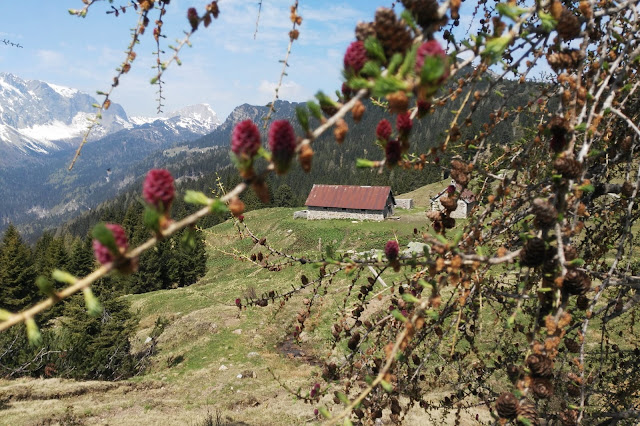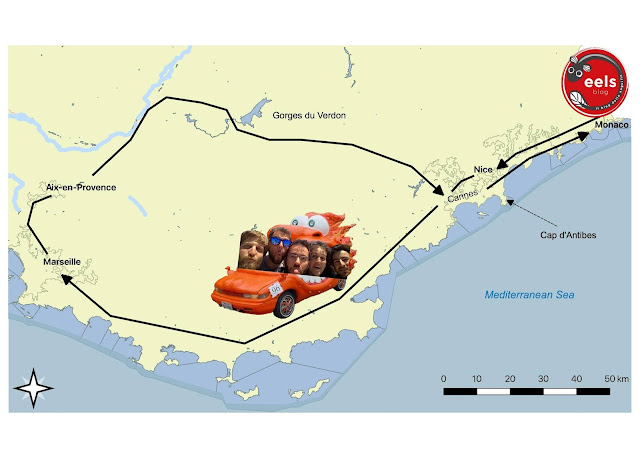
It's the beginning of September but we totally feel the cold of 5 am as we approach Udine by train. The sun is still hidden behind the Alps and the few passengers around us seem sleepy. But they are certainly not going to such an exotic place and they don't have the adrenaline rush of the beginning of a journey like we do.
As Yasmin and I descend towards the south, perched villages and semi-arid fields alternate with the large stations and suburban areas we pass through. Sitting next to us, two old ladies who are now widows have found each other and talk about how nice it is to travel together. Puglia, Campania, Sicily...but strictly at the end of season "or eotherwise it would be too much chaos". I don't tell them, also because they think I'm not Italian, but I fully agree with them: it's very nice to travel together with someone else. And in the end we arrive: Naples.
The first impression just outside the station is of North Africa. Dirt, traffic and hot air. Then, walking along Corso Umberto I in the direction of our accommodation, the traffic and the ubiquitous stalls mingle with noble palaces, university buildings and fashion shops. This is something new for me, which perhaps I have only glimpsed in Palermo.
 |
| Above: One of the rare city dustmen in Naples; Below: a well swiped off scooter |

The sea. We look for it immediately, and we can see it but we can't reach it. The pier next to the Maschio Angioino is interrupted by a military zone. In the other direction a long harbour strip begins, mostly closed to the public. While alongside the sea, cars tussle with eachother on the avenue.
People. When I take off my shirt I don't notice that my ID card has ended up on the ground. A couple on a motorbike behind us does notice it, stops to pick it up and chases us to give it back. A farmer who’s regulating the irrigation of his field is waiting for nothing more than a good morning to start chatting and inquire about my life. A bartender asks me how I am doing and insists on not believing my answer. An old lady in line wants to make sure that nobody passes me and protects me. Caterers and vendors who enjoy offering small gifts and pointing out how those are not included in the final bill. So many small flashes which might not be representative, but they certainly smell of generosity, irony and curiosity. In a word: humanity.
Pizza. In Naples there is generally no hurry. One prefers to postpone and not immediately think about what has to be done, unless it is not strictly necessary. But when the good in question is pizza, it is necessary that the pizzaioli move quickly and that there is a clear and efficient system to manage the customers. Since the whole city is a customer, or at least I get this impression. Both the places we come across, one renowned and the other one specialized in fried pizzas, have kilometric rows and precise systems to respect the order of arrival. In both pizzas, the thing I love most is the tomato sauce. Followed by pasta, so good that once we’re finished there is no crust left in my carton (never happened before!). We eat them both by the sea, because in the end - if you want - you always find an outlet to the sea. But you'll have to struggle a bit to find it.
Privacy. We also struggle to find the cathedral. We walk back and forth in Via dei Tribunali, the Greek-Roman Cardio, but we still miss the crossroad to the cathedral. Once again we see the target (behind the rooftops) but the road is being blocked. On the other hand we have a panorama over the lives of the inhabitants of the city. Conversations on the phone or from one moped to another, pieces of street fenced in like a balcony and windows wide open on the street where everyday scenes take place or where, more frequently, someone sits down and looks us straight in the face. But in the old Naples you go beyond the deprivation of privacy, you feel really pulled up your sleeves in all directions.
Claustrophobia. The port and market area is historically the poorest and most densely populated area. It is therefore the most filthy area, but also the most touristy because it is in the heart of the city. Especially in the evenings, whether you walk along the crowded arteries of the neighborhood or take a detour along the smelly side streets, the prevailing feeling is one of claustrophobia and the desire is to escape to open and less shady spaces.
 |
| Corners in old Naples |

The following day Naples is a different city. The pedestrianised Naples of Piazza del Plebiscito and the elegant Naples of Monte Sant'Elmo belong to some other galaxy than what we’ve seen the previous evening. The sky shines over the sea and the Vesuvius, while everything seems clear and shimmering from above. The funicular takes us back to the sea level, to Montesanto, where a small table is promptly set up for us on the sidewalk of a street and we are served a superb pasta asciutta.
Names of places. Some religious, others dialectical, others Greek and Latin sounding. But certainly not univocal. In fact Google Maps takes us to Pozzuoli, instead of Bagnoli, while we are looking for the Villa of Posillippo. But it doesn't matter, since there’s plenty of Roman remains there too, including the amphitheatre wanted by Nero, which is still standing and is hosting a concert in a few hours.
Stratifications. Perhaps not even in Rome do you go so "down" in time. The underground of Naples are in fact already incredible like this and much has not yet been excavated. As a guide tells us, "you can't tear down history to look for more history". And so you only dig where you do not go to destroy anything, which is very rare in Naples. But in other cases there is no need to dig a lot because the underground has never really been abandoned. As in the case of the 40 kilometres of Roman aqueduct, kept in use until the outbreak of cholera in 1883 and reused as anti-aircraft shelters in the Second World War by thousands of Neapolitans. In Naples you can live the present by stepping on history with your feet, but on the other hand it has always been like that and you don't pay much attention to it.
Books. Maybe I have never seen so many books on sale as in Naples, and it is a great sign. The books already welcome you at the mega Feltrinelli of the central station, but it is the small bookshops in the centre with their stalls - especially in the area of Piazza Dante, near the University - that fill the streets with books and culture. You can perceive a cultured Naples, student movements and literary cafés.
At the end of our stay in Naples, before heading towards the beaches of Cilento, we emerge from the underground and are greeted by the tarantellas of a quartet of street artists. We make the “Pizza wallet”experience, which is a good lunch despite costing one euro. Although still lacking in peace and quiet, it is difficult to leave Naples.
 |
| The view from Monte Sant'Elmo |

 |
| Nerone's anphiteatrum in Pozzuoli |
Paestum. We pass through Salerno, skirt the sea for a while, cross countryside full of greenhouses and finally arrive at the dilapidated, but undergoing renovation, station of Paestum. Another evocative name, assigned by the Lucans population to the Greek colony of Posydonia, and never changed again. Also because the city was forgotten for several centuries, being in the middle of a marsh (now reclaimed) and too close a target for the maritime fleets of the past.
In fact, there are less than two kilometres from the seafront pine trees where we are camped to the Greek city. In non pirate and non-touristic times it is a great luxury to have the temples of Athena so within walking distance. I realise this already the first morning when I go exploring at dawn, woken up by the dogs in the neighbourhood, woken up in turn by the cockerels of the farm next to our campsite.
But it is also true that the urge to show the world the beauty of Paestum has in the past led to the construction of roads all around the Greek city. The Archaeological Park, which occupies a relatively small part of the area bounded by the Greek walls, is in fact bordered by a fairly busy provincial road (even at dawn!) and a series of farms that carry out their tractor activities "within the walls".
 |
| Medea in Paestum |

In addition to the town of Paestum, we also enjoy the beach of Paestum very much. The desire for adventure fades in the face of the gentle fluctuation of the waves and our exploratory and semi-sporting souls give way to a sedentary soul which loves good living.
And just as this sandy beach, as relaxing as it is rich in stories (from the sirens of the Odyssey, to the succession of ancient populations and finally to the bloody clashes between the Allies and the Germans in '43), so too was our journey. And there is no better place than this to conclude its story.
















































